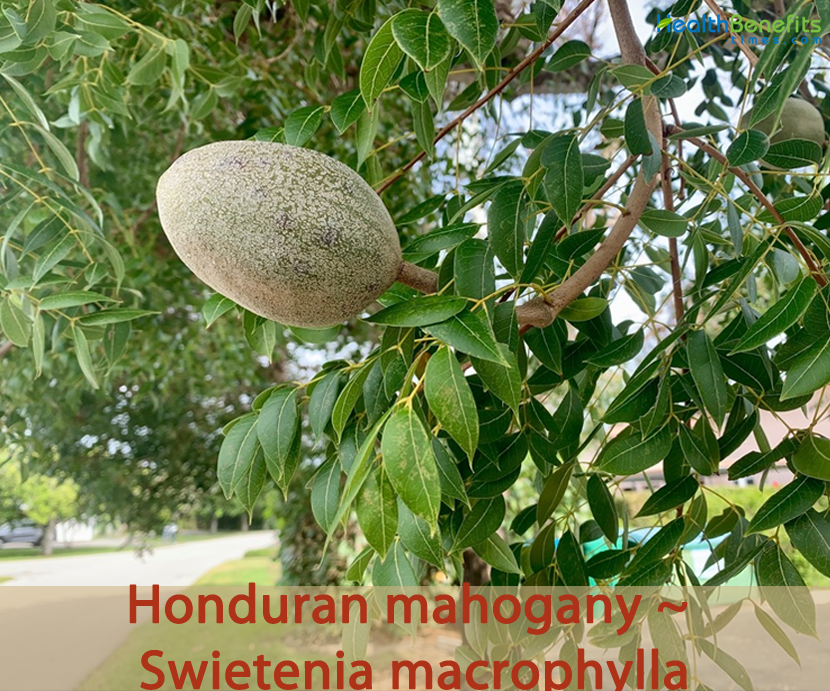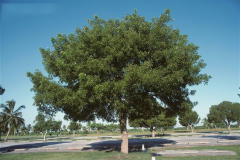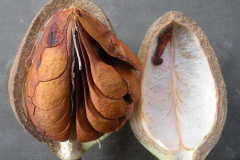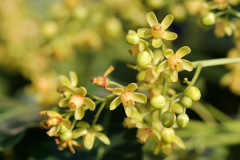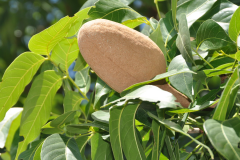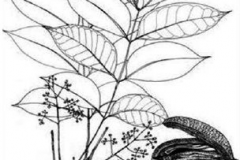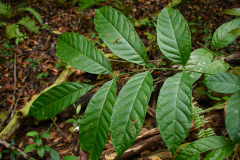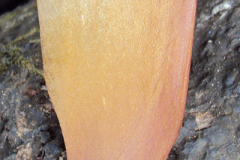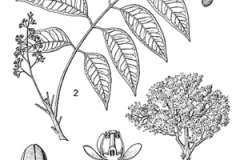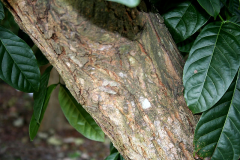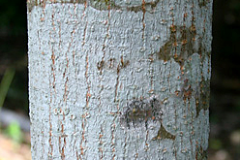| Honduran mahogany Quick Facts | |
|---|---|
| Name: | Honduran mahogany |
| Scientific Name: | Swietenia macrophylla |
| Origin | South America, Mexico and Central America, but naturalized in the Philippines, Singapore, Malaysia and Hawaii |
| Colors | Light grey to brown |
| Shapes | 5-lobed capsule, oblong or ovoid fruit, 11.6–38.7 cm in length, 6.7–12.0 cm in diameter |
| Taste | Bitter |
| Health benefits | Control Blood Sugar, Boost Fertility, Improves Heart Health, Hypertension, Boosts Immune System, Cures Fever and Malaria, Increases Appetite, Wound-Healing Abilities, Insect repellent, Treat Constipation, Menstrual Pain, Make Women Fertile, Cure Fever and Cold, Eczema and Rheumatism |
| Name | Honduran mahogany |
|---|---|
| Scientific Name | Swietenia macrophylla |
| Native | South America, Mexico and Central America, but naturalized in the Philippines, Singapore, Malaysia and Hawaii |
| Common Names | American mahogani, Baywood, Bigleaf mahogany, Broadleaf mahagony, Honduras mahogany, Mahogany, Large-leaved mahogany, Honduran mahogany, Brazilian Mahogany, Large-leaved Mahogany, New World Mahogany, sky fruit tree |
| Name in Other Languages | Afrikaans: Mahonie Albanian: Sofër Amharic: Mahogany (ማሆጋኒ) Arabic: Shajarat almahughani (شجرة الماهوغاني) Armenian: Karmrap’ayt tsarr (կարմրափայտ ծառ) Azerbaijani: Qırmızı ağaj Basque: Mahogany Belarusian: Cyrvonaje dreva (чырвонае дрэва) Bengali: Mēhagani br̥kṣa (মেহগনিবৃক্ষ) Bolivia: Mara Bosnian: Mahagonija Brazil: Acaju, aguano, araputanga, araputango, caoba, cedro, cedro-aguano, cedroí, cedro-mogno, cedrorana, mara, mara-vermelho, mogno, mogno, mogno-aroeira, mogno-branco, mogno-brasileiro, mogno-cinza, mogno-claro, mogno-de-marabá, mogno-do-Rio-Jurupari, mogno-escuro, mogno-peludo, mogno-rosa, mogno-róseo, mogno-vermelho Bulgarian: Makhagon (махагон), Edrolistno makhagonovo dŭrov (Едролистно махагоново дъров) Catalan: Caoba Cebuano: Mahogany Chichewa: Ananyamula Chinese: Da ye tao hua xin mu (大叶桃花心木 ), táohuā xīn mù (桃花心木) Corsican: Machja Croatian: Od mahagonija Czech: Mahagon Danish: Mahogni, Bredbladet Mahogni Dutch: Mahonie, Amerikaans Mahonie English: American mahogani, Baywood, Bigleaf mahogany, Broadleaf mahagony, Honduras mahogany, Mahogany, Large-leaved mahogany, Honduran mahogany, Brazilian Mahogany, Large-leaved Mahogany, New World Mahogany Esperanto: Mahagono, Grandfolia svitenio Estonian: Mahagon Finnish: Mahonki, Amerikanaitomahonki Filipino: Kamagong French: Acajou à feuille large, Acajou d’ Amérique, Acajou des Antilles, Mahogany à grandes feuilles, Swiéténie, Mahogani Grands Feuilles, acajou Frisian: Mahony Galician: Carballo Georgian: Ts’iteli (წითელი) German: Amerikanisches Mahagoni, Echtes Mahagoni, Honduras-Mahagoni, Nicaragua-Mahagoni, Tabasco-Mahagoni, Honduras-Mahagonibaum Greek: Maóni (μαόνι) Gujarati: Mahōganī (મહોગની) Haitian Creole: Akajou Hausa: Mahogany Hawaiian: Mahogany Hebrew: מַהֲגוֹנִי Hindi: Mahoganee vrksh (महोगनी वृक्ष) Hmong: Mahogany Hungarian: Mahagóni Icelandic: Mahogany Igbo: Mahogany Indonesian: Mahoni Irish: Mahagaine Italian: Mogano, mogano americano Japanese: Ooba mahoganii (オオバマホガニー), Mahoganī (マホガニー) Javanese: Mahoni Kannada: Mara (ಮರ) Kazakh: Qızıl ağaş (қызыл ағаш) Kinyarwanda: Mahogany Khmer: Kreabbek I (គ្រាប់បែក I), mahogany Korean: Mahogani (마호가니) Kurdish (Kurmanji): Mahogany Kyrgyz: Mahogany Lao: Ma hok kani (ມະຮອກການີ) Latin: Mahogany Latvian: Sarkankoks Lithuanian: Raudonmedis Luxembourgish: Mahagony Macedonian: Mahagoni (махагони) Malagasy: Rotra Malay: Mahogani Malayalam: Mahagani (മഹാഗണി), Manthagani Maltese: Kawba Maori: Mahogany Marathi: Tyācē jhāḍa (त्याचे झाड) Mongolian: Zandan (зандан) Myanmar (Burmese): Lout aalayyhkyane shitae (လောက်အလေးချိန်ရှိတဲ့) Nepali: Mahoganee (महोगनी) Norwegian: Mahogni Odia: Mahogany Pashto: مهوگني Persian: چوب ماهون Peru: Aguano Philippines: Arawakan Polish: Mahon Portuguese: Caóba, Mogno, Araputangá, Cedroaraná, Cedroi, Águano, mogno-das-Honduras, Mogno-do-Brasil Punjabi : Mahōganī (ਮਹੋਗਨੀ) Romanian: Mahon Russian: Krasnoye derevo (красное дерево) Samoan: Mahogany, mahoki, mahokani Scots Gaelic: Mahogany Serbian: Mahagoni (махагони ) Sesotho: Mahogany Sindhi: Mahuni (مهوني ) Sinhala: Mahogani, mæhōganī (මැහෝගනී) Shona: Mahogany Slovak: Mahagón Slovenian: Mahagoni Somali: Caawitaanka Spanish: Aguano, Araputanga, Caoba, Caoba de Centro América, Caoba de hoja ancha , Caoba de Honduras, Caoba del Atlántico, Caoba del Sur , Cóbano, Crura, Gateado, Mara, Mara boliviana, Mogno, Mogu, Orura, Sapoton, Venadillo, Yulu, Zapatón, Zopilote, Ahuano Sundanese: Mahoni Swahili: Mahogany Swedish: Hondurasmahogny, mahogany Tajik: Mahogany Tamil: Mahōkaṉi (மஹோகனி), Thenkani (தேன்கனி), Makākaṉi (மகாகனி) Tatar: Machohany (махоганы) Telugu: Mahagani, peddakulamaghani Thai: Maḥxkkānī (มะฮอกกานี), Maḥxkkānī bı h̄ıỵ̀ (มะฮอกกานีใบใหญ่) Tonga: Mahokani Turkish: Maun Turkmen: Mahogany Ukrainian: Chervone derevo (червоне дерево) Urdu: مہوگنی Uyghur: Mahogany Uzbek: Maun Vietnamese: Cây gụ, Nhạc ngựa Welsh: Mahogany Xhosa: Mahogany Yiddish: Makhagani (מאַכאַגאַני) Yoruba: Mahogany Zulu: Mahogany |
| Plant Growth Habit | Beautiful, fast growing, evergreen or briefly deciduous, shade tolerant tropical tree |
| Growing Climates | Semi evergreen and evergreen rain forests, forest edges, dry forests, disturbed sites, secondary forests, riparian forest, mixed hardwood forest belts, along riverbanks |
| Soil | It tolerates soils ranging from deep, poorly drained, acid clays of the wooded swamps, to well drained alkaline soils of the limestone uplands. Maximum development is attained on deep, fertile, moist, well-drained, neutral to mildly alkaline soils |
| Plant Size | 30 – 40 meters tall and 2 meters in diameter, but specimens up to 60 meters tall can be found in favorable conditions |
| Root | Buttress roots up to 5 meters above the base, which increases the diameter of the trunk to more than 10 meters, making it necessary to cut the tree at more than 2 meters above the ground |
| Bark | Bark grey and smooth when young, turning dark brown, ridged and flaky when old |
| Leaf | Leaves are usually paripinnate, sometimes imparipinnate, 12-45 cm long and made up of 3-6 pairs of ovate or ovate-lance shaped leaflets. The leaflets are asymmetric, 5-12 cm long, and 2-5 cm wide, with pointed or long pointed tip |
| Flower | Tree produces small, fragrant, white unisexual flowers 0.5–1.0 cm in length, which are held in inflorescences called panicles including both male and female. |
| Fruit Shape & Size | 5-lobed capsule, oblong or ovoid fruit, 11.6–38.7 cm in length, 6.7–12.0 cm in diameter and light grey to brown with 4–5 valves |
| Fruit Color | Light grey to brown |
| Seed | Seeds with large wing, flat, 7.5–10 cm long, dark brown, hanging down and overlapping in fruit; cotyledons thin |
| Taste | Bitter |
| Plant Parts Used | Roots, seeds, leaves, and bark |
| Propagation | By seeds |
| Health Benefits |
|
Plant Description
Honduran mahogany is a beautiful, fast growing, evergreen or briefly deciduous, shade tolerant tropical tree with an open, rounded crown. The plant normally grows about 30 – 40 meters tall but specimens up to 60 meters tall can be found in favorable conditions. The bole is straight and cylindrical with a buttressed base – it usually has a diameter of 100 – 120 cm, but in exceptional conditions up to 280 cm has been recorded. It usually has buttress roots up to 5 meters above the base, which increases the diameter of the trunk to more than 10 meters, making it necessary to cut the tree at more than 2 meters above the ground. Bark is reticulate, grey and smooth when young, turning dark brown, ridged and flaky when old. The outer bark of older trees is scaly, shaggy, deeply longitudinally furrowed and brownish-grey to reddish-brown, and the inner bark is red-brown or pinkish-red. Young branches are glabrous, with fine patterns.
It is a very well-known and valuable timber; mahogany is regarded as the world’s finest timber for high-class furniture and cabinet work. The tree has been heavily exploited within its native range, becoming virtually extinct in some areas, with populations everywhere in steep decline. It is now cultivated in plantations in many parts of the tropics. It is planted as an ornamental lawn tree in peninsular Malaysia. The plant is found growing in semi evergreen and evergreen rain forests, forest edges, dry forests, disturbed sites, secondary forests, riparian forest, mixed hardwood forest belts and along riverbanks. It tolerates soils ranging from deep, poorly drained, acid clays of the wooded swamps, to well drained alkaline soils of the limestone uplands. Maximum development is attained on deep, fertile, moist, well-drained and neutral to mildly alkaline soils.
Leaves
The leaves are usually paripinnate, sometimes imparipinnate, 12-45 cm long and made up of 3-6 pairs of ovate or ovate-lance shaped leaflets. The leaflets are asymmetric, 5-12 cm long, and 2-5 cm wide, with pointed or long pointed tip. The leaflets are even in number and are connected by a central midrib. Young leaves are pink or red, and gradually change to dark green when mature.
Flowers
The tree produces small, fragrant, white unisexual flowers 0.5–1.0 cm in length, which are held in inflorescences called panicles including both male and female.
Fruit
Fertile flowers are followed by 5-lobed capsule, oblong or ovoid fruit, 11.6–38.7 cm in length, 6.7–12.0 cm in diameter and light grey to brown with 4–5 valves. Outer valves are woody; 5-7 mm thick while inner valves are much thinner. In the center is a woody, 5 angled columella extending to the apex. The fruits split open from apex or base when they are ripe and dry. Each fruit consists of 22–71 developed seeds.
Seeds
Seeds are brown, oblong, compressed, crested, samaroid, bulky at their base, 7–12 cm long and 2–2.5 cm wide including the wing.
Wood
Mahogany wood is strong and is used for construction materials, plywood, high-grade furniture and cabinet making. It is also suitable for paneling, framing, flooring, automobile bodies, interior trim of boats, radio and phonograph cabinets, bodies of musical instruments, moldings and other ornaments.
Health benefits of Mahogany
Listed below are some of the popular health benefits of using Honduran mahogany
1. Control Blood Sugar
Drinking the extract from mahogany bark is effective in controlling blood sugar levels. This is due to the presence of saponin, which is a natural anti-diabetic remedy. Research reported that mahogany bark extract showed significant hypoglycemic activity might be used in the future for the development of phyto-medicines for diabetes mellitus.
2. Boost Fertility
Parts of the mahogany tree, including the bark, have been used as local treatment of fertility in men and women. In men, it has been said to cure impotence or erectile dysfunction as it improves erection. In women, it increases the chances of getting pregnant. However, there is still very little scientific evidence to support this claim.
3. Improves Heart Health
Mahogany bark also has a positive effect on the heart. Flavonoid content in the bark decreases the risk of heart diseases and also reduces the buildup of bad cholesterol and fats in the blood. Flavonoids also improve blood circulation and usually improve the cardiovascular system.
4. Hypertension
Mahogany seed is able to treat hypertension. Simply collect 8 grams of mahogany seeds, then brewed with 2 glasses of hot water. After cool then filter and divide into two parts / glass. Drink in the morning and afternoon. It is helpful in treating hypertension.
5. Boosts Immune System
Flavonoids are regarded as antioxidants, which help to fight free radicals in the body. Free radicals can cause harm by contaminating cells. This causes cancer in some cases. Antioxidants also boost the immune system and make it easy for the body to fight infections and diseases.
6. Cures Fever and Malaria
Mahogany bark has also been used as a local cure for fever and malaria. Just boil the bark in water and drink it while still hot or warm. One research stated that mahogany had potential antimalarial properties.
7. Increases Appetite
Drinking mahogany bark extract might help to increase appetite. This can be great for those who are recovering from fever or malaria. So, using mahogany bark would not only fight off the illness but would also bring back one’s appetite.
8. Wound-Healing Abilities
Mahogany bark has wound-healing abilities. A 2020 research published in the Journal of Medicinal Plants Research showed to this. Research also stated that the bark had antibacterial properties.
9. Insect repellent
Mahogany seed also acts as an insect repellent. When the mahogany seed is made into a powder, it can serve as an insect spray. For those who live in the tropics or where there are enough insects can use mahogany powder as an additional intake to help strengthen the body against diseases caused by insects or transmitted by insects.
10. Treat Constipation
Mahogany seeds can also be used to cure constipation. Consumption of this fruit (mashed) then mixed with warm water to relieve constipation.
11. Menstrual Pain
To overcome the pain during menstruation use herbal medicine from the seeds of mahogany. Consuming mahogany seeds early in the menstrual cycle will reduce the pain.
12. Make Women Fertile
Consuming 1 mahogany per day will increase fertility. Especially if you are a woman who has not had children and want to feel the pregnancy.
13. Cure Fever and Cold
Mahogany seeds are able to cure flu (colds) and fever. Take 1/2 teaspoon mahogany powder mixed with 1/4 cup hot water with a tablespoon of honey. Drink while still warm; drink 2-3 times a day.
14. Eczema and Rheumatism
Take 1/2 teaspoon of mahogany powder and put in 1/2 cup hot water, add one tablespoon of honey. Drink while still warm. Do it three times a day.
Traditional uses and benefits of Honduran Mahogany
- The bark is astringent, bitter and febrifuge.
- An infusion is used to treat diarrhea and fevers.
- Fruit has been used commercially in health care products for the improvement of blood circulation and skin condition.
- In Malaysia, the seeds are used traditionally to treat hypertension, diabetes, and relieve pain.
- Seeds have been reported to have anti-inflammatory, anti-mutagenicity and antitumor activity.
- A Bolivian Amazonian ethnic group has used the seeds for leishmaniasis and as an abortion medicine.
- In Indonesia, seeds have been used as a folk medicine for treatment of diabetes, hypertension, and malaria.
- Bark extract has been used as an astringent for wounds and used occasionally for tanning because of the rich red color it provides.
- It is said to repair tissue, promote blood circulation, and regulate blood pressure and sugar levels.
- It helps to slow the aging process and prevent disease plus colds and flues.
- Mahogany seeds powder lowers cholesterol and helps to boost your immune system.
- Mahogany seeds increases circulation and lower blood pressure and have anti-inflammatory effects.
- Seeds help to prevent cardiovascular disease and strokes.
- It helps get rid of plaque formation within the vessels of the heart, plus reduces pain and bleeding.
- Researches have been done showing that Mahogany seeds may be great for treating Hepatitis C.
- Mahogany Seed powder can help prevent insect bites.
- Mahogany seed treat hypertension, blood sugar disorders, poor appetite, fever, and facilitate maintain sturdiness.
- In Bolivia the Mesetemo Indians use a decoction of the crushed seeds to bring about an abortion, and use the crushed seeds with the oil from Attalea phalerata for skin problems and children’s skin allergies.
- In Malaysia the seeds are chewed, or swallowed in powder form to treat high blood pressure.
- In Indonesia a decoction of the seeds is given against malaria and other diseases.
- Decoction or infusion made with the crushed seeds is said to increase the male libido and so has a reputation as an aphrodisiac, touted in supplements for erectile dysfunctions.
Other Facts
- It is used as a shade tree for cacao, coffee and young plantations of dipterocarps.
- Farmers have planted it among subsistence crops such as corn, beans, bananas, sweet potatoes and cassava in Puerto Rico.
- Crushed fruit shells have been used as a potting medium.
- Gum is produced from cuts in the bark.
- It is marketed in both pure form and mixed with other gums.
- The bark is used for dyeing and tanning leather.
- Oil, which is very bitter and purgative, can be extracted from the seed kernels.
- Heartwood is reddish, pinkish, salmon colored, or yellowish when fresh; deepening with age to deep rich red or brown; it is distinctly demarcated from the up to 40mm wide band of yellowish or whitish sapwood.
- Lustre is high and golden; the texture rather fine to coarse; the grain straight to roey, wavy, or curly, often with an attractive figure.
- The dense wood is of medium weight, it is reasonably durable, but it is not considered suitable for applications in contact with the ground.
- It seasons well, without much checking or distortion.
- Attractive wood is mostly valued for high-class furniture and cabinet work; it has also been used in interior paneling, joinery work, turnery, plywood and heavy construction work.
- Its outstanding technical qualities make it particularly suitable for precision woodwork such as models and patterns, instrument cases, clocks, printer’s blocks and parts of musical instrument.
- Veneer quality is limited by color variation, wavy grain, pin knots and pinhole borer damage.
References:
https://www.itis.gov/servlet/SingleRpt/SingleRpt?search_topic=TSN&search_value=29027#null
http://www.hear.org/pier/species/swietenia_macrophylla.htm
https://pfaf.org/USER/Plant.aspx?LatinName=Swietenia+macrophylla
https://gd.eppo.int/taxon/SWIMA
https://indiabiodiversity.org/species/show/231280
http://www.theplantlist.org/tpl/record/kew-2601504
https://en.wikipedia.org/wiki/Swietenia_macrophylla
https://www.cifor.org/publications/pdf_files/Books/BKrisnawati1110.pdf
https://www.ncbi.nlm.nih.gov/pmc/articles/PMC6270564/
https://tropical.theferns.info/viewtropical.php?id=Swietenia+macrophylla
https://plants.usda.gov/home/plantProfile?symbol=SWMA
https://www.flowersofindia.net/catalog/slides/Big-Leaf%20Mahogany.html
https://www.cabi.org/isc/datasheet/52155


